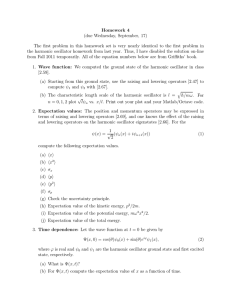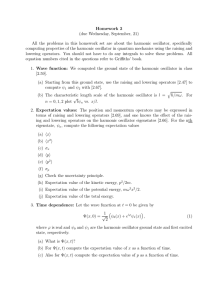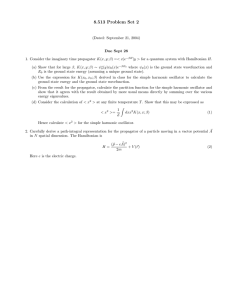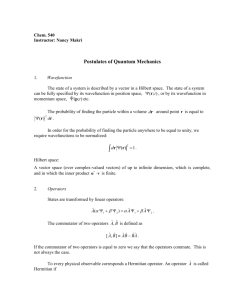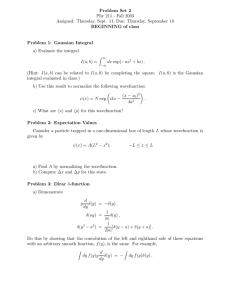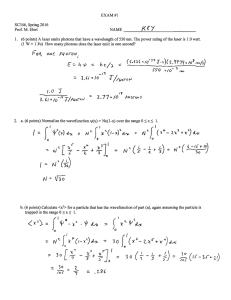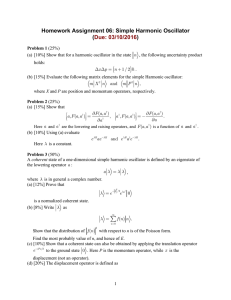Harmonic Oscillator: Raising and Lowering Operators Part Deux
advertisement
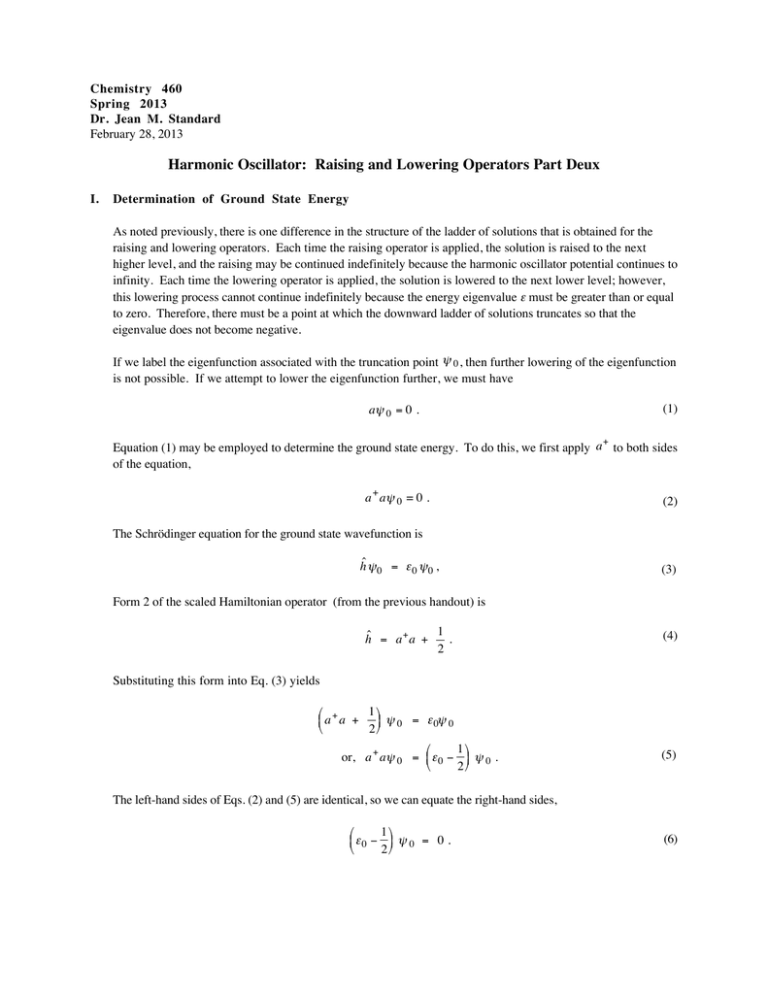
Chemistry 460
Spring 2013
Dr. Jean M. Standard
February 28, 2013
Harmonic Oscillator: Raising and Lowering Operators Part Deux
I.
Determination of Ground State Energy
As noted previously, there is one difference in the structure of the ladder of solutions that is obtained for the
raising and lowering operators. Each time the raising operator is applied, the solution is raised to the next
higher level, and the raising may be continued indefinitely because the harmonic oscillator potential continues to
infinity. Each time the lowering operator is applied, the solution is lowered to the next lower level; however,
this lowering process cannot continue indefinitely because the energy eigenvalue ε must be greater than or equal
to zero. Therefore, there must be a point at which the downward ladder of solutions truncates so that the
eigenvalue does not become negative.
If we label the eigenfunction associated with the truncation point ψ 0 , then further lowering of the eigenfunction
is not possible. If we attempt to lower the eigenfunction further, we must have
(1)
aψ 0€= 0 .
+
Equation (1) may be employed to determine the ground state energy. To do this, we first apply a to both sides
of the equation,
€
a + aψ 0 = 0 .
€
The Schrödinger equation for the ground state wavefunction is
€
hˆ ψ 0 = ε 0 ψ 0 ,
(2)
(3)
Form 2 of the scaled Hamiltonian operator (from the previous handout) is
€
1
hˆ = a + a +
.
2
(4)
Substituting this form into Eq. (3) yields
€
1 ⎞
⎛ +
⎜ a a + ⎟ ψ 0 = ε 0ψ 0
⎝
2 ⎠
1 ⎞
⎛
or, a + aψ 0 = ⎜ ε 0 − ⎟ ψ 0 .
⎝
2 ⎠
(5)
The left-hand sides of Eqs. (2) and (5) are identical, so we can equate the right-hand sides,
€
1 ⎞
⎛
⎜ ε 0 − ⎟ ψ 0 = 0 .
⎝
2 ⎠
€
(6)
2
Since the ground state wavefunction ψ 0 is not equal to zero, we can divide both sides of Eq. (6) by it to give
1
= 0,
2
1
or ε 0 = .
2
ε0 −
€
(7)
Since the relationship between the scaled energy ε and the energy E is ε = E / hν 0 , the ground state energy,
sometimes referred to as the zero-point energy,
becomes
€
E0 =
II.
1 €
hν .
2 0
(8)
Determination of Energy Eigenvalues
€
Since ε 0 =
1
, and each eigenvalue differs by 1, we can construct the entire set of scaled eigenvalues,
2
1
2
3
ε1 =
2
5
ε2 =
2
7
ε3 =
2
ε0 =
€
εn = n +
1
.
2
(9)
Again, using the definition ε = E / hν 0 , this yields the full set of energy eigenvalues,
€
1 ⎞
⎛
En = hν 0 ⎜ n + ⎟ ,
⎝
2 ⎠
€
III.
n = 0, 1, 2, …
(10)
Determination of the€ Ground State Wavefunction
We can use the truncation of the downward ladder of solutions, Eq. (1), aψ 0 = 0 , to determine the ground state
wavefunction ψ 0 . Substituting the definition of the lowering operator, we have
1
2
€
€
(
aψ 0 = 0
€
ˆ
ˆ
P − i Q ψ0 = 0 .
)
(11)
3
d
Since Pˆ = − i
, this equation becomes
dQ
⎞
−i ⎛ d
+ Q⎟ ψ 0 = 0 .
⎜
⎠
2 ⎝ dQ
€
(12)
Multiplying both sides by − 2 /i , this equation becomes
€
⎛ d
⎞
+ Q⎟ ψ 0 = 0 ,
⎜
dQ
⎝
⎠
€
or
dψ 0
+ Qψ 0 = 0 .
dQ
(13)
dψ 0
= − Q dQ .
ψ0
(14)
Rearranging yields
€
This equation may be integrated to obtain ψ 0 ,
€
dψ
∫ ψ 00
€
∫
= − Q dQ
lnψ 0 = −
Q2
,
2
or ψ 0 = e −Q
2
/2
(15)
.
Note that because Eq. (14) was integrated using an indefinite form, the ground state wavefunction ψ 0 obtained
in Eq. (15) is valid only up to an arbitrary
constant,
€
ψ 0 = Ae −Q
2
/2
.
€
(16)
The constant A may be determined by normalization, which requires
€
∞
∫ ψ ( x) ψ ( x)
*
0
0
dx = 1 .
(17)
−∞
In Eq. (17), it is important to realize that the wavefunctions should be normalized in the original (unscaled)
variable x; thus, the integration is over
€ x rather than Q. Substituting the form of ψ 0 from Eq. (16), and
making the assumption that A is real, the normalization expression becomes
∞
A2
∫ e −α x
2
€
dx = 1 .
(18)
−∞
The integral in Eq. (18) may be found in integral tables. The result is
€
∞
∫e
−∞
€
−α x 2
⎛ π ⎞1/2
dx = ⎜ ⎟ .
⎝ α ⎠
(19)
4
Substituting into Eq. (18) gives
⎛ π ⎞
A 2 ⎜ ⎟
⎝ α ⎠
1/ 2
= 1,
⎛ α ⎞
or A = ⎜ ⎟
⎝ π ⎠
1/ 4
(20)
.
Therefore, the complete form of the ground state wavefunction is
€
⎛ α ⎞
ψ 0 ( x ) = ⎜ ⎟
⎝ π ⎠
1/ 4
e −α x
2
/2
(21)
.
IV. Determination of Other Wavefunctions
€
Once the ground state wavefunction has been determined explicitly, the others may be obtained by application of
the raising operator using the relation
a +ψ n =
(22)
n + 1 ψ n +1 .
For example, to generate ψ 1, we set n=1 in Eq. (22) to obtain
€
ψ 1 = a +ψ 0 .
(23)
€
+
Substituting the definition of a yields,
€
ψ1 =
€
=
⎛ α ⎞
Since ψ 0 = ⎜⎝ ⎟⎠
π
(24) gives
€
1/ 4
e −Q
2
/2
and
dψ 0
⎛ α ⎞
= ⎜ ⎟
⎝ π ⎠
€dQ
1/ 4
1 ˆ
P + i Qˆ ψ 0
2
⎞
i ⎛ d
+ Q ⎟ ψ 0 .
⎜−
⎠
2 ⎝ dQ
(
(24)
⎛ −Q e −Q 2 / 2 ⎞
⎝
⎠ , substitution of these relations into Eq.
⎛ α ⎞
ψ 1 = i ⎜ ⎟
⎝ π ⎠
€
)
1/ 4
2 Q e −Q
2
/2
(25)
,
Alternately, this wavefunction may be expressed in terms of the unscaled coordinate x,
€
⎛ α ⎞
ψ 1 ( x ) = i ⎜ ⎟
⎝ π ⎠
1/ 4
2α x e −α x
2
/2
.
(26)
Notice in Eq. (26) that the wavefunction includes a factor of i; however, since the probability density depends on
the absolute square of the wavefunction,
€ the i can be dropped so that the wavefunction is real.
5
V.
Determination of Expectation Values
Given an operator Oˆ , the expectation value of Oˆ in the state ψ is
(27)
O = ψ Oˆ ψ ,
€
€
€
as long as ψ is normalized. Expectation values involving harmonic oscillator states can be evaluated easily
using the properties of raising and lowering
€ operators. For example, consider the evaluation of the average
position for the nth state of the harmonic oscillator,
€
(28)
x = ψ n xˆ ψ n .
The first step in evaluation of the expectation value is to express the operator xˆ in terms of the scaled variables.
In this case, the definition
€
⎛ mk ⎞1/ 4
Qˆ = ⎜ 2 ⎟ xˆ
⎝ ⎠
€
(29)
may be employed to yield the relation
€
⎛ 2 ⎞
= ⎜
⎟
⎝ mk ⎠
x
1/ 4
ψn Q ψn .
(30)
Next, the variable Q may be expressed in terms of the raising and lowering operators. Using the definitions
1 ˆ
1
a=
P − i Qˆ and a + = €Pˆ + i Qˆ , we can take linear combinations of these two relations to obtain
2
2
(
)
(
)
i
2
Qˆ =
€
€
(a − a ) .
+
(31)
Substituting into Eq. (30) gives
€
x
1/ 4
=
i ⎛ 2 ⎞
⎜
⎟
2 ⎝ mk ⎠
i
2
⎛ 2 ⎞
⎜ mk ⎟
⎝
⎠
1/ 4
=
ψ n a − a+ ψ n
{ ψn
a ψn − ψn
a+ ψ n
}.
(32)
The integrals in Eq. (32) may be evaluated using the equations for the raising and lowering operators,
€
aψn =
a+ ψ n =
n ψ n −1
(33)
n + 1 ψ n +1 .
Substituting,
x
€
=
€
1/ 4
⎛
i 2 ⎞
⎜
⎟
2 ⎝ mk ⎠
{
n
ψ n ψ n −1
−
n + 1 ψ n ψ n +1
}.
(34)
6
Since the eigenfunctions are orthogonal,
ψn ψm
= 0, for n ≠ m .
(35)
Therefore, both integrals in Eq. (34) are zero by orthogonality, and the expectation value is
€
x
= 0.
(36)
While this result should have been expected since positive and negative values of the position are equally likely
due to the symmetry of the potential, this example
illustrates a powerful procedure for evaluation of more
€
complex expectation values or other expressions that involve integrals based on the use of raising and lowering
operators.

